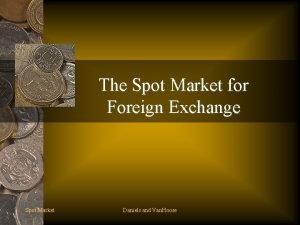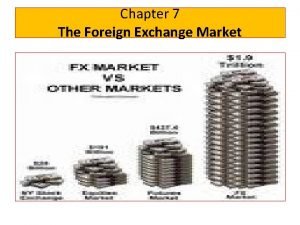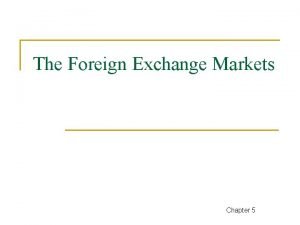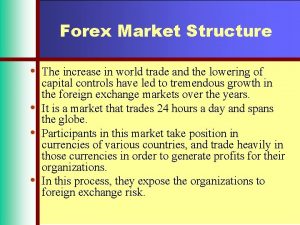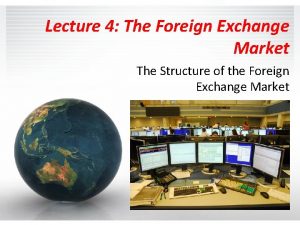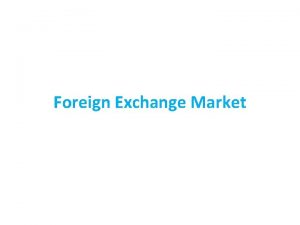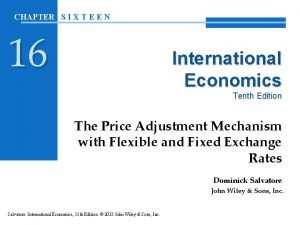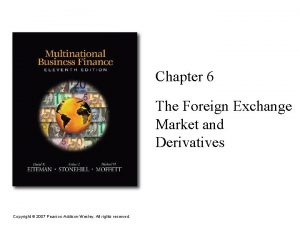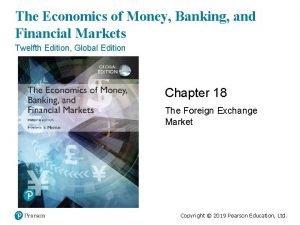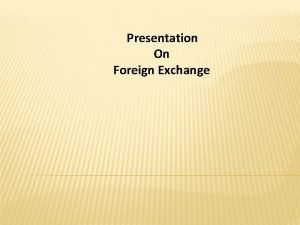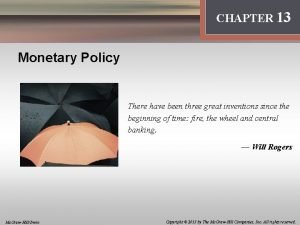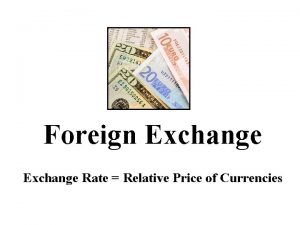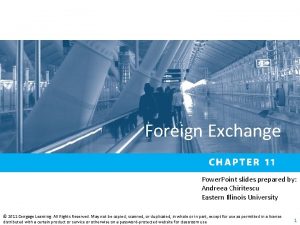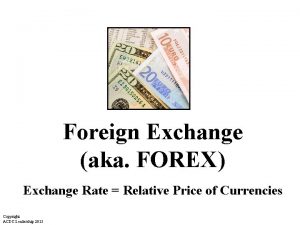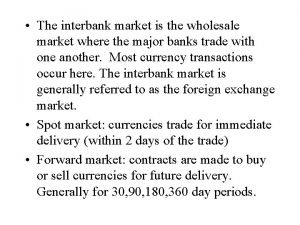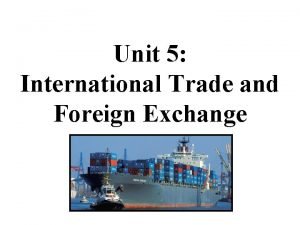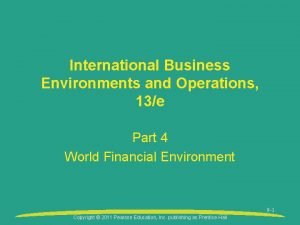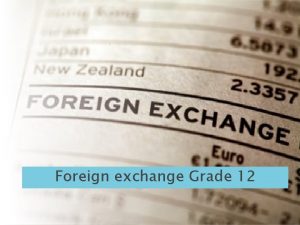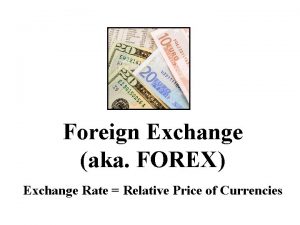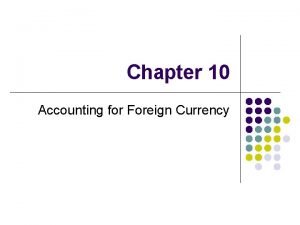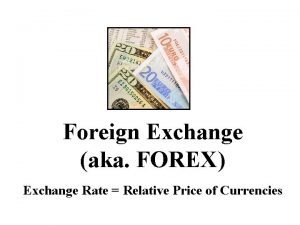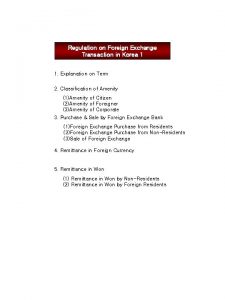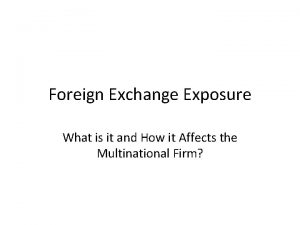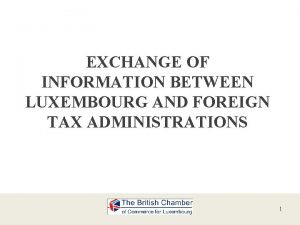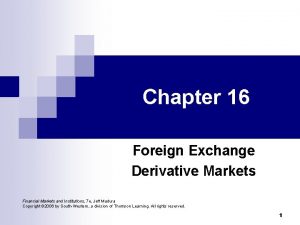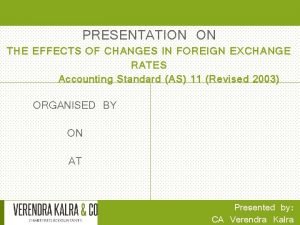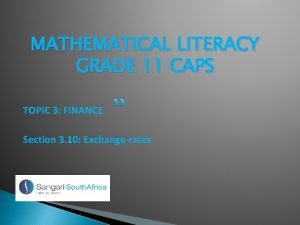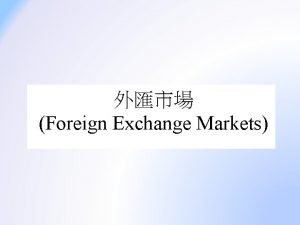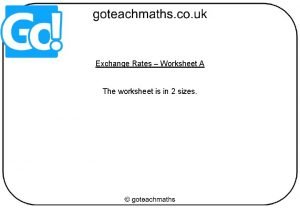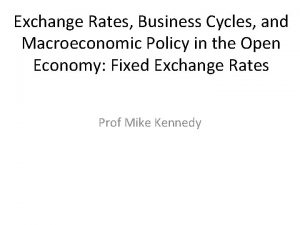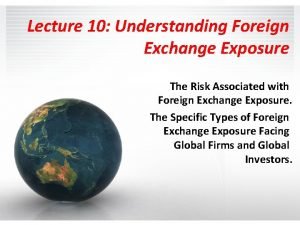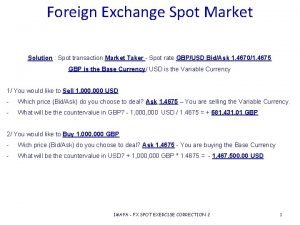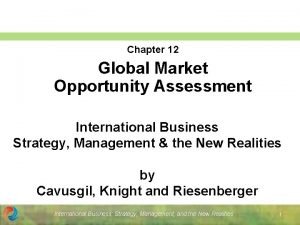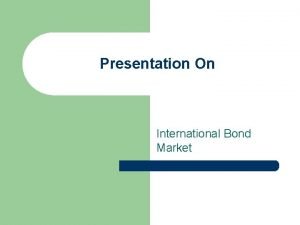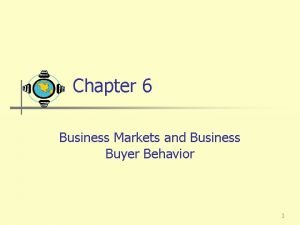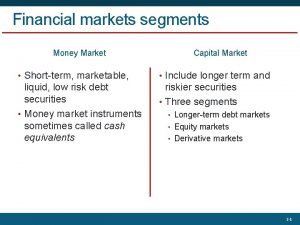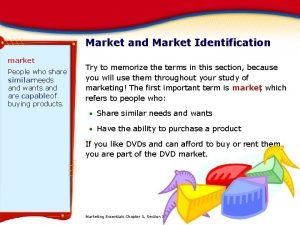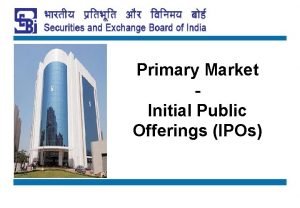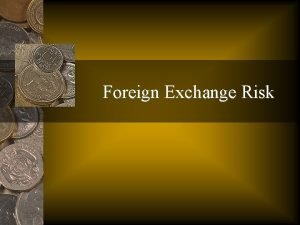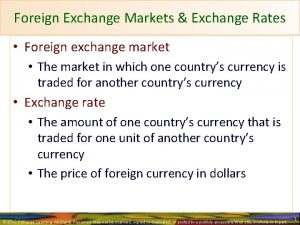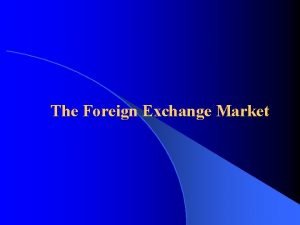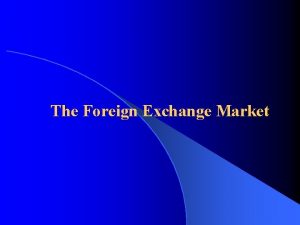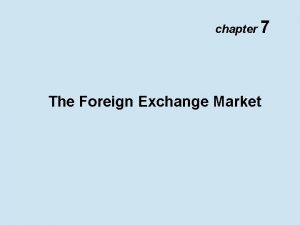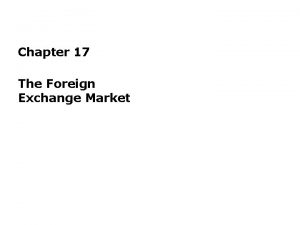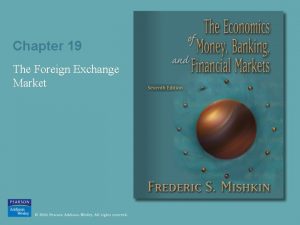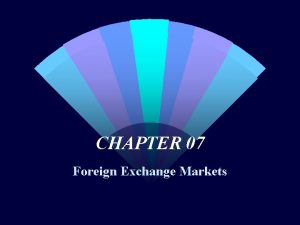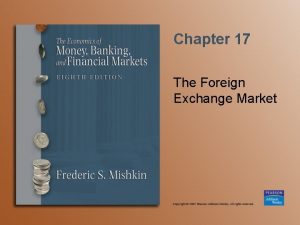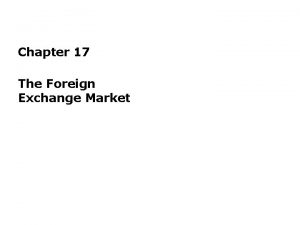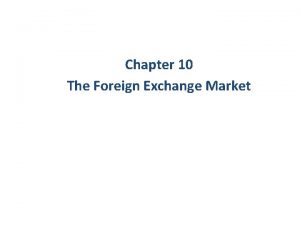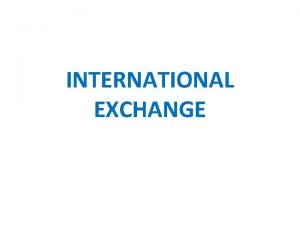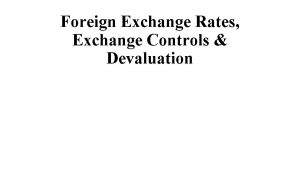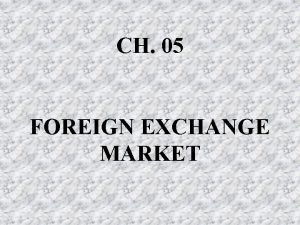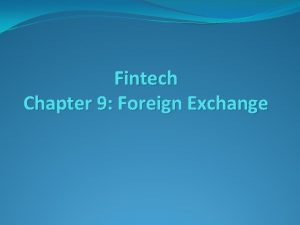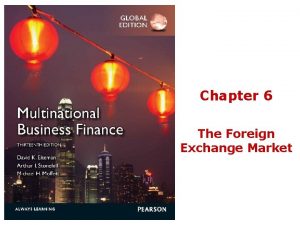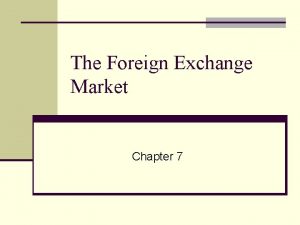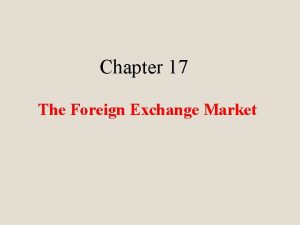Chapter 3 Foreign Exchange Market and Foreign Exchange













































![n EER 2009 = [(. 509)(. 9612) + (. 491)(1. 0625)] x 100 = n EER 2009 = [(. 509)(. 9612) + (. 491)(1. 0625)] x 100 =](https://slidetodoc.com/presentation_image/6933c6d8d9474c2288444e5f69a52688/image-46.jpg)


- Slides: 48

Chapter 3 Foreign Exchange Market and Foreign Exchange Rate

Foreign Exchange Market n Foreign exchange is another country’s money. The dynamic meaning of the foreign exchange refers to the act of trading different country’s currencies. n Convertibility means a currency can be freely exchanged for another currency. This is the most important characteristic of the foreign exchange.

n Foreign exchange rate is the price of one currency in terms of another. n Foreign exchange market is the place where currencies are bought and sold. n The foreign exchange market is by far the largest financial market in the world. n Foreign exchange market has two functions: the first is to convert one currency into another (the spot exchange market); the second is to provide insurance against foreign exchange risk (the forward exchange market).

n The foreign exchange market is an informal, over-the-counter and around-the-clock market. n It has no centralized meeting-place and no formal requirements for participation. n The market never sleeps. Tokyo, London, and New York are all shut for only 3 hours out of every 24. During these three hours, trading continues in a number of minor centers, particularly San Francisco and Sydney.

Measuring foreign exchange market activity: Average electronic conversions per hour

n As of 2009, more than $3 trillion are traded in this market on a daily basis. This was a massive increase of nearly 70% over the 2004 survey’s estimate of $1. 9 trillion. n The U. S. dollar was involved in more than 90% of all foreign exchange transactions, followed by the euro (38%), yen (23%), and British pound sterling (13%). n London is the largest world foreign exchange market, followed by New York and Tokyo. London accounts for 34. 1% of daily world exchange. New York is about 16%.

Global foreign exchange market turnover, 1998 2010 (daily averages in April, billions of U. S. dollar)

Top 10 geographic trading center in the foreign exchange market, 1992 -2007 (daily averages in April, billions of $)

Customers buy $ with ¥ Local banks Foreign exchange brokers Major banks Interbank markets Local banks n Foreign exchange market structure Customers buy ¥ with $ MNCs & Others

Participants in the foreign exchange market n Retail customers are made up of individuals, international investors, small businesses, speculators or the like who need foreign exchange. n Commercial banks (market dealers) carry out buy/sell orders from their retail clients and buy/sell currencies on their own account.

n Dealers often function as market makers who stands ready to buy and sell at quoted exchange rates, earning their profit by the difference of the bid and ask price. n Small- to medium-size banks are not market makers in the interbank market. They buy from and sell to larger banks to offset retail transactions with their own customers.

n Foreign exchange brokers do not put their own money at risk. They serve three purposes in the market. First, they are the sources of information. Second, they bring buyers and sellers together and contributes to market efficiency. Third, they make it possible for traders to remain anonymous. n Businesses such as MNCs are the major nonbank participants in the market. n Central banks buy and sell currencies in a bid to influence the exchange rate.

Spot Exchange Market and Exchange Rate Quotations n The spot exchange market is a market that deals in foreign exchange for immediate delivery. Immediate delivery in foreign currencies usually means within two business days. n A spot exchange rate is the current market price, the rate at which a foreign exchange dealer converts one currency into another currency on a particular day.

Foreign exchange rate quotations on the U. S. Dollar/British Pound in the Financial Press

n An exchange of currencies involves two currencies. Either of which may be placed in the denominator. The quotation of the exchange rates follows conventions. n Direct quote is the amount of domestic currency per unit of foreign currency. In Japan ¥ 115 = € 1 In Canada C$1. 50 = ₤ 1 n Indirect quote is the amount of foreign currency per unit of domestic currency. In England $1. 60 = ₤ 1

n American quote is the dollar per currency quote, i. e. the price of other currencies in terms of the dollar. Example: US$ 1. 57 = £ 1 US$ 1. 35 = € 1 n European quote is the currencies per dollar quote, i. e. the price of the dollar in terms of the other currencies. Example: A$ 1. 02 = US$ 1 € 0. 74 = US$ 1

n Bid and ask quotes are the prices at which a bank likes to buy and sell standard amounts of foreign currency. Example: $1. 0206/SFr Bid $1. 0217/SFr Ask n When bid is lower than ask, the bank is buying or selling the currency in the denominator of the quote. n When bid is higher than ask, the bank is buying or selling the currency in the numerator of the quote.

n Example: SFr 0. 9798/$ Bid SFr 0. 9787/$ Ask The bank spends one dollar to buy SFr 0. 9798; It sells SFr 0. 9787 for one dollar. n Bid-ask spread is the difference between the bid and ask price. It is usually expressed by “point”. n Example: SFr 1. 0206/$ Bid SFr 1. 0217/$ Ask Here bid-ask spread is SFr 0. 0011/$ or 11 basis points.

n one basis point = 1% of 1% = 0. 0001 n When the spread is expressed as a percent of the ask price, it is called bid – ask margin. n Bid – ask margin = (ask – bid)/ask x 100 n Example: SFr 1. 0206/$ Bid SFr 1. 0217/$ Ask Bid – ask margin = [(1. 0217 – 1. 0216) / 1. 0217] x 100 = 0. 1077%

n A cross rate is the rate which is calculated from two other bilateral exchange rate. S(x/y) = S(x/z) / S(y/z) n Example: Suppose ¥/$ 6. 6766 and SFr/$ 0. 9644, applying the above formula, ¥/SFr = 6. 6766/0. 9644 = 6. 9230 n The following formula is available when both the bid and ask prices are calculated: Sa(x/y) = Sa(x/z) / Sb(y/z) Sb(x/y) = Sb(x/z) / Sa(y/z)

n Examples: If J¥/$ = 85. 01 – 08 and SFr/$ = 0. 9855 – 65 J¥/SFr (bid) = 85. 01/0. 9865 = 86. 17 J¥/SFr (ask) = 85. 08/0. 9855 = 86. 33 n If $/₤ = 1. 6000 – 10 and J¥/$ = 85. 01 – 08 J¥/₤ (bid) = 1. 6000 x 85. 01 = 136. 01 J¥/₤ (ask) = 1. 6010 x 85. 08 = 136. 21

Foreign exchange cross rates at close of business, 4 January 2005

The Value of a Currency n When a currency gains value relative to another, the currency appreciates. Otherwise, it depreciates. In foreign exchange market, if the demand for dollar is more than the supply of the dollar, the dollar appreciates. n Percentage change in foreign currency value: (Ending rate – Beginning rate) (Beginning rate)

n Example: 6 months ago: CHF/USD 1. 0235 right now: CHF/USD 0. 9644 Percentage change in the value of the dollar: (0. 9644 – 1. 0235) / 1. 0235 x 100 = -5. 77% The dollar depreciated against the franc by 5. 77%. Annual depreciation rate: 11. 54%. n Percentage changes in currency values are asymmetric. When the dollar is depreciated against franc by 11. 54% p. a. , it does not mean the franc is appreciated against the dollar by 11. 54% p. a.

n To calculate the percentage change in Swiss franc, we can use the following formula: (Beginning rate – Ending rate ) (Ending rate) n Applying the formula, the change in Swiss franc is: (1. 0235 – 0. 9644) / 0. 9644 = 6. 13% The Swiss franc appreciates against the dollar by 12. 26% annually.

Foreign Exchange Arbitrage n Arbitrage means a profitable position obtained with no net investment and no risk. n Foreign exchange arbitrage refers to buying one currency in one place and selling it in another place at the same time. n Spatial arbitrage refers to arbitrage activities conducted across two different geographical markets.

n Suppose $/Dkr = 0. 1584 – 0. 1594 in New York, and the exchange rate (Dkr/$) is 6. 3520 – 6. 3540 in London, what should the foreign exchange trader do to make profit? n Assume the trader has $1 million line of credit and both markets are open without any restrictions against buying and selling currencies. The trader should buy Danish krone in London and sell the krone for dollar in New York.

n Buying Kroner in London: $1 m x 6. 3520 = Dkr 6. 3520 m (in London) n Selling Kroner in New York: Dkr 6. 3520 m x 0. 1584 = $1. 006157 m (in New York) n Profit: $1. 006157 m - $1 m = $6, 157 n Such arbitrage is practical only if the participants have instant access to quotes and executions. Bank traders can conduct such arbitrage without an initial sum of money, other than their bank’s credit standing.

n The no-arbitrage condition for triangular arbitrage in the currency markets is: (three currencies d, e, f, are involved) Sd/e· Se/f·Sf/d = 1 n If the product of the three exchange rates is not equal to one. An arbitrage opportunity exists. A rule for determining which currencies to buy and sell in triangular arbitrage.

n If Sd/e· Se/f·Sf/d < 1, buy the currencies in the denominators with the currencies in the numerators. n If Sd/e· Se/f·Sf/d > 1, sell the currencies in the denominators for the currencies in the numerators. n Example. If in New York $/¥ = 0. 00960984, in Tokyo ¥/SFr = 60. 75, in Zurich SFr/$ = 1. 7125, is there an arbitrage opportunity?

n The product of these exchange rates is Sd/e·Se/f·Sf/d = S$/¥·S¥/SFr·SSFr/$ n Since 0. 00960984 x 60. 75 x 1. 7125 = 0. 999754 < 1 then, Buy ¥ with $, (1 m)/0. 00960984 = ¥ 104. 06 m Buy SFr with ¥, 104. 06/60. 75 = SFr 1. 712922 m Buy $ with SFr, 1. 712922/1. 7125 = $ 1. 000246 m n Profit: 1. 000246 m – 1 m = $246. 00

The Forward Foreign Exchange Market n Forward foreign exchange market is forward foreign exchange transactions. It means the rates and the amounts of the deal are agreed on today but settlement occurs sometime in the future. n Forward exchange rate is defined as the rate to be paid for delivery of specific currency at some future date.

Forward Premium and Discount Spot: Forward: (90 days) basis points Bid Ask ¥ 120. 25/€ ¥ 118. 84/€ ¥ 120. 45/€ ¥ 118. 97/€ Bid ¥ 120. 25/€ -141 Ask ¥ 120. 45/€ -148

n Forward premium: a currency is trading at a forward premium when the value of that currency in the forward market is higher than in the spot market. n Forward discount: a currency is trading at a forward discount when the value of that currency in the forward market is lower than in the spot market. n Formula forward premium/discount (n) [(Ftd/f – S 0 d/f)] / (S 0 d/f) n: number of compounding periods per year

Example n If S 0$/SFr = 1. 04 and F 6$/SFr = 1. 0000 Swiss franc is selling at a 6 -month forward discount $0. 0400/SFr, or 400 basis points. Annualized percentage deviation from the spot rate is: (n) [(Ftd/f – S 0 d/f)] / (S 0 d/f) = (2) [(1. 0000 – 1. 0400)] / 1. 0400 = -0. 06923 = 6. 923% discount rate annually

Foreign Exchange Risk n Foreign exchange risk refers to fluctuations in the domestic value of assets, liabilities, income or expenditure due to unanticipated changes in exchange rates. n Risk exists when the future is unknown; that is, whenever actual outcomes can deviate from expected outcomes. n Foreign exchange exposure is what is at risk.

n Transaction exposure is the extent to which the income from individual transactions is affected by fluctuations in foreign exchange values. n Translation exposure is the impact of currency exchange rate changes on the reported financial statements of a company. Translation exposure is basically concerned with the present measurement of past events.

n Economic exposure is the extent to which a firm’s future international earning power is affected by changes in exchange rates. Economic exposure is concerned with longrun effect of changes in exchange rates on future prices, sales, and costs. n Hedging is the act of offsetting exposure to risk. n Long position in foreign currency means foreign currency or a claim in foreign currency is owned.

n Short position in foreign currency means a foreign currency liability is owed. n A Chinese exporting company expects to receive the U. S. dollar in the near future. The company takes long position on the dollar. If a company will pay dollar, the company takes short position on the dollar. n Hedging a long position refers to selling foreign exchange forward. n Hedging a short position involves buying foreign exchange forward.

company’s income in RMB Unhedged position 6. 90 m 6. 85 m 6. 80 m Hedging with a forward contract 6. 80 6. 85 6. 90 ¥/$ spot rate

company’s expenditure in RMB Unhedged position 6. 90 m 6. 85 m 6. 80 m Hedging with a forward contract 6. 80 6. 85 6. 90 ¥/$ spot rate

Real exchange rate and effective exchange rate n Nominal exchange rate is the exchange rate that prevails at a given date. n Real exchange rate is the nominal exchange rate adjusted for relative changes in domestic and foreign price levels. That is, adjusted for inflation differential. So the real exchange rate captures changes in the purchasing power of a currency relative to other currencies. SR = Sd/f x (Pf/Pd)

n Effective exchange rate is a measure of whether or not the currency is appreciating or depreciating against a weighted basket of foreign currencies. n To construct an effective exchange rate, you have to select: a currency basket a base year the weights for each of the currencies in the basket.

Nominal exchange rates and trade volume to the United States millions of U. S. dollar Country S (2008) S(2009) Canada Japan C$1. 03/$ C$0. 99/$ ¥ 80/$ ¥ 85/$ Exports Imports to U. S. from U. S. 275 235 Total U. S. foreign trade: (275 + 150) + (235 + 175) = $835 m 150 175

n Example: 2008 (base year) Canadian dollar, Japanese yen (currency basket) Weight for C$: $425 m / $835 m = 50. 90% Weight for ¥: $410 m / $835 m = 49. 1% n Compared to the Canadian dollar, the value of the dollar in 2009 was 96. 12% of the value in 2008 (0. 99/1. 03). n Compared to the Japanese yen, the value of the dollar in 2009 was 106. 25% of the value in 2008 (85/80).
![n EER 2009 509 9612 4911 0625 x 100 n EER 2009 = [(. 509)(. 9612) + (. 491)(1. 0625)] x 100 =](https://slidetodoc.com/presentation_image/6933c6d8d9474c2288444e5f69a52688/image-46.jpg)
n EER 2009 = [(. 509)(. 9612) + (. 491)(1. 0625)] x 100 = 101. 10% n The value indicates that the average value of the U. S. dollar against the Canadian dollar and the Japanese yen in 2009 was 101. 10% of the value in 2008. Therefore, the dollar was “stronger”.

Nominal effective exchange rate indices 1980– 2004 (annual averages)

Real effective exchange rate indices, 1980– 2004
 Spot market in foreign exchange market
Spot market in foreign exchange market Kinds of foreign exchange market
Kinds of foreign exchange market Objectives of foreign exchange
Objectives of foreign exchange Structure of the forex market
Structure of the forex market Structure of foreign exchange market
Structure of foreign exchange market Foreign exchange market features
Foreign exchange market features Stability of foreign exchange market
Stability of foreign exchange market Foreign exchange market example
Foreign exchange market example Equilibrium exchange rate graph
Equilibrium exchange rate graph Foreign exchange market slideshare
Foreign exchange market slideshare Foreign exchange graph
Foreign exchange graph Exchange market graph
Exchange market graph Foreign exchange market
Foreign exchange market Forex market shifters
Forex market shifters Interbank wholesale
Interbank wholesale Market segmentation objectives
Market segmentation objectives Market leader challenger follower nicher
Market leader challenger follower nicher Too foreign for home
Too foreign for home Difference between balance of trade and balance of payment
Difference between balance of trade and balance of payment Types of exchange rate
Types of exchange rate Fx process
Fx process Bbr and bsr meaning
Bbr and bsr meaning Foreign exchange shifters
Foreign exchange shifters Fx accounting
Fx accounting Xlri exchange program
Xlri exchange program 4 shifters of foreign exchange
4 shifters of foreign exchange Foreign exchange transaction regulation korea
Foreign exchange transaction regulation korea Hsbc spot foreign exchange
Hsbc spot foreign exchange Types of foreign exchange exposure
Types of foreign exchange exposure Christophe joosen
Christophe joosen Foreign exchange means
Foreign exchange means Foreign exchange derivative
Foreign exchange derivative Integral foreign operation
Integral foreign operation Exchange rates maths lit grade 12
Exchange rates maths lit grade 12 Fema 1999 objectives
Fema 1999 objectives Wise exchange program
Wise exchange program Synthetic forward rate agreement
Synthetic forward rate agreement Exchange rates worksheet
Exchange rates worksheet Exchange rate graph economics
Exchange rate graph economics Transaction exposure example
Transaction exposure example Spot transaction
Spot transaction International market opportunity analysis
International market opportunity analysis Eurobond market size
Eurobond market size Primary target market and secondary target market
Primary target market and secondary target market Business markets and business buyer behavior
Business markets and business buyer behavior How to find bond equivalent yield
How to find bond equivalent yield Concept of market identification
Concept of market identification Difference between primary market and secondary market
Difference between primary market and secondary market Money market components
Money market components
